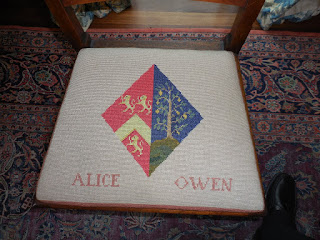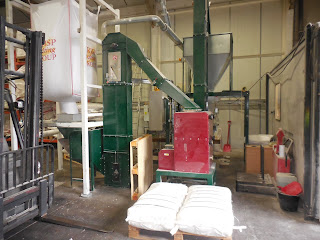Brewers' Hall, home of The Worshipful Company of Brewers, is unsurprisingly riddled with heraldic devices. The origins of Brewers' Company go back to medieval times and it's fascinating to see that something with such a long history still exists. Though when you hear
the beadle shout "PRAY SILENCE FOR THE MASTER" you're reminded that shit though capitalism may be feudalism wasn't much cop either.
The
JIB archive once again came up trumps when searching for information on the heraldry on display, as there's an article from 1937 on it*. The hall in existence at that time (the second one) was flattened by the Luftwaffe but the current incarnation seems to have restored most of the medieval whatnots.
Heraldry has its own rules and way of saying things (coming from French). Two metallic colours are used: or (gold) and argent (silver). Non-metallic colours used are gules (vermillion red), azure (blue), sable (black), vert (green), purpure (royal purple), murray (dark red) and tawny (dull orange). Then there are the furs such as ermine (black tails with a white field), ermines (white tails on a black field) and erminites (black and red tails on a white field). Things can also be shown in their natural colours in which case they're called "proper".
Each part of a shield is named and sinister and dexter are used for left and right. Though this seems to be from the perspective of someone who was holding the shield as facing it the dexter is on the left and sinister on the right. Chief is used for top, and base for bottom.
There are also a number of terms used how the various things (called
charges) found on heraldic devices are placed such as:
Bend: runs from dexter chief to sinister base the width of a
pale. Two bends in combination (i.e. a bend and a sinister bend) for a
saltaire. The lower half of a saltaire forms a
chevron.
Cross patee: a cross spreading outwards towards its extremities.
Ensigned: distinguished by any mark on or over a charge.
Escutcheon: the shield
Fesswise: charges lying horizontally.
Flaunch: a segment of a circle of a different colour projecting into the field from either side of the escutcheon.
Flory-counterflory: a succession of fleur-de-lis alternately reversed and counterchanged.
Fret: a hollow lozenge interlaced by a saltaire. A combination of frets is called fretty.
Impalement: where two coats of arms are place side by side on a shield separated by a vertical line.
Lozenge: widows and spinsters don't get shields so their armorial bearings are displayed on a lozenge.
Lozengy: when the field is cut into diamonds by many lines running saltairewise.
Orle: a narrow border following the outline of the shield.
Pale: when the shield is bisected by two vertical lines the space between them is known as a pale. If the lines are close together it's a pallet.
Pall: a device of archbishops formed from two bends and a pale. It'll be easier when you see this one.
Tressure: an orle divided into two narrow ones set closely together.
Vairy: a furry field of various colours.
Are you still with me?
The second Brewers' Hall replaced one destroyed in the Great Fire of London and had the arms of Charles II, reigning monarch at the time it was built (1673), in one of its windows, and they've got it on the wall in the current hall.
The first and forth quarters represent France (English kings didn't give up their claim to France until 1801) and England (that is: azure three fleur-de-lis or gules three lions passant guardant in pale or), the second quarter Scotland (or a lion rampant within a double tressure flory and counterflory gules) with the third quarter Ireland (azure a harp or stringed argent). The writing on the belt is old French saying: "spurned be the one who evil thinks" and the writing at the bottom is French for "God and my right".
Brewers' Company was first known as The Guild of Our Lady and St. Thomas à Becket, and they claim the latter as their founder, so here's his armorial bearings:
and here's a drawing:
Thomas à Becket (c1118-1170) having been the Archbishop of Canterbury here we have: "The armorial bearings of the see of Canterbury,
viz., Azure and archiepiscopal staff ensigned with a cross patee in pale or surmounted by a pall argent edged and fringed gold charged with four crosses pastees-fitchee sable; impaled with those of "The Founder",
viz.:- Argent three choughs two and one sable beaked and legged gules - the shield ensigned with a Mitre or."
Prior to the reformation "The Founder's" bearings were impaled with those of Brewers' Company (barrels and barley, no hops here):
The Brewers' Company, having control of unhopped ale production in London at first actively campaigned against the foreign hop using beer brewers.
Thomas à Becket, a priest famous for standing up to a
king, fell out of favour when Henry VIII was busy nationalising the
church and dissolving the monasteries so his arms were dropped and the Brewers' Company arms were since used on their own.
The Armorial Bearings of The Brewers' Company (second grant) in full are here:
and here's the drawing:
This is gules on a chevron engrailed argent between three pairs of barley garbs in saltire or three tuns sable hooped of the third. Bonus points for those that noticed the chevron on the drawing is incorrect as it isn't
engrailed. The crest is a demi Moorish woman couped at the knees proper her hair dishevelled or habited azure frettee argent holding in each hand three ears of barley of the second. The motto is in English so I guess they didn't do Latin at school either.
The Moorish woman is a cryptic reference to Thomas à Becket retained by the sneaky brewers, as his stepmother was reputed to be a moor.
The City of London armorial bearing are on the wall, as Brewers' Company was very much a London thing:
drawn here:
This is "argent a cross gules in the first quarter a sword point upwards to the last" with a crest of "a dragon's sinsiter wing argent charged with a cross gules".
The motto translates as "lord, guide us".
Next is the arms of Richard Platt (1528-1600):
Here was have "or fretty sable on each joint a plate" with a crest of a demi lion rampant proper holding in the paws a plate.
Richard Platt was twice master of the Brewers' Company and founded
Aldenham School, which is still supported by the Brewers' Company today.
Next up is the armorial bearings of Dame Alice Owen (1547-1613):
and here's the drawing:
What we have here, as I'm sure you'll have worked out, is "dexter gules a chevron or between three lions rampant of the second; impaling the arms of her father,
viz.:- Azure a pomegranate tree eradicated vert fructed or".
Dame Alice Owen was a wealthy widow (which is why her arms are on a lozenge) who outlived three husbands. One of these was a brewer and on her death she left the governing of a
school she had established to the Brewers' Company. The school is also still supported by the company, including giving the pupils
beer money!
Next we have the arms of James Hickson (1607-1689):
I'm sure it's obvious to all that what we have here is "or two eagles' legs erased a la quise in saltire sable a trefoil vert for difference with a crest issuant out of a ducal coronet or a griffin's head sable beaked of the first charged with a trefoil gold". The motto means "faith and fortitude".
A knight's arms follow, those of Sir Samuel Stirling (decd. 1674).
The shield has the straightforward "argent on a bend azure three square buckles or" with a crest of "hand dexter chucking a shuriken". Ha! Had you there, it's really "from a mount vert a cubit arm erect proper the hand holding an estoile or". Sir Samuel was a former master of the Brewer's Company who left a property (since sold) to it in his will.
I didn't spot the next one but in case you happen to find it in Brewers' Hall it's the arms of Baron Willoughby of Parham (1696-1775) with a simple "or fretty azure". The crest is a bit more involved though, being "a Saracen's head affrontee couped at the shoulders proper ducally crowned or". Henry Willoughby was another master of the Brewer's Company.
The motto is "truth without fear", which reminds me of someone from my Thai boxing club who had a proper mid-life crisis when he hit 40. He got "truth" tattooed on one arm, "courage" on the other, told his boss to stick his job up his arse, and left his wife. The last I heard he'd met someone new and had a kid so I guess it worked out OK for him.
I didn't spot the next one either. Whether it's not in the current Brewers' Hall or I just missed it I couldn't say but just in case here's the arms of Baron Hawley of Donamore (1719-1790):
Those of you that have been paying attention will I'm sure be thinking "ah, engrailed lines again" with the shield showing "vert a saltire engrailed argent" and the crest is "an Indian goat's head couped holding a three-leaved sprig of holly all proper". How they can tell that the goat is Indian I don't know. The motto is in French this time and says "follow me". Samuel Hawley was elected master of the Brewers' Company four times.
I'm old enought to know which family the next coat of arms belongs to...
... because I can remember when Whitbread was a brewery, not a coffee and hotel company. I recognised the arms of Samuel Whitbread: "argent a chevron between three hinds' heads erased gules" with a crest of a hind's head erase gules. The motto says "virtue is not simple".
Samuel Whitbread also left property to the Brewers' Company.
Lastly there's arms connected to another brewery I can remember:
These belong to Harry Charrington and are "gules a gryphon's head erased between two crosses patee in pale or two flaunches vaire azure and of the second" with the crest "on a wreath of the colours a demi-gryphon gules gorged with a collar gemelle charged on the shoulder with two annulets interlaced and resting the sinister claw on a cross patee all or and holding in the dexter claw a branch of thorn-tree proper". Sadly the motto isn't about black currents, which surely would have put Charrington's well ahead of their time in terms of beer flavour, instead it reads: "virtue is the safest helmet". Harry Charrington left money to the Brewers' Company.
Charrington's IPA was the first IPA I ever drank. It was brown, sweet and 3.9% ABV, part of the authentic century old tradition of weak, lightly hopped IPAs quite unlike the strong and hoppy modern interpretations seen nowadays.
As well as the arms on the walls there were also some embroidered seats, and this time they handily put the name by the arms:
We've already had Richard Platt.
Sydney O Neville ended up as a big cheese at Whitbread, and I've written about him
here. At one point he was the master of the Brewers' Company. His portrait can also be seen in Brewers' Hall:

Next was this:

John Mann I assume of the Mann's brewery fame.

I don't know anything about John Martineau, but it appears he was
found dead in a yeast trough.

Alice Owne we've already had.

The Institute of Brewing basically adapted the Brewers' Company arms for their own. The relatively young age of the Institute doesn't stop it getting a coat of arms as this sort of thing still goes on today. As indeed does making new livery companies, the Worshipful Companies of Management Consultants, International Bankers and Tax Advisers being recent additions.
And finally here's in full the rug with the arms of the Brewers' Company and the schools it supports:

* Heraldry and Brewers' Hall, W.H. Bird. Journal of the Institute of Brewing, December 1937.

edited by Annie Hill and with a chapter by me.
















































